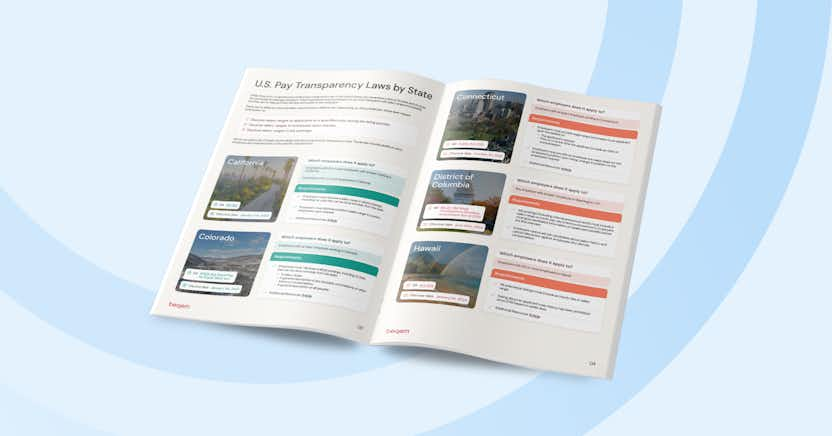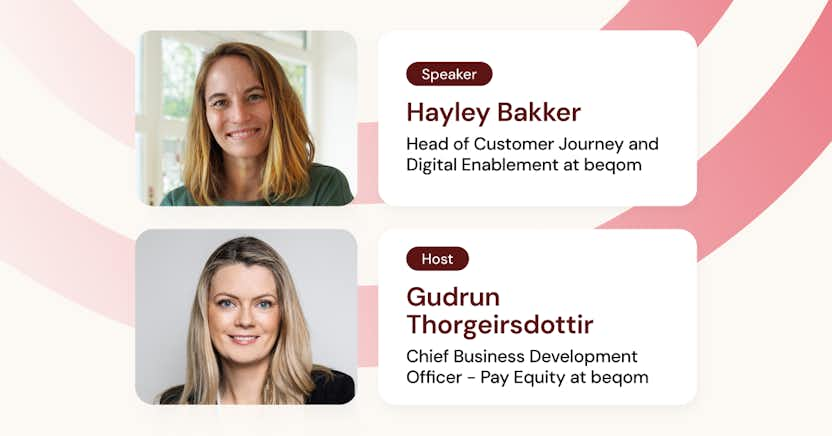The 3 Pillars of a High-Performance Culture

Products used
As HR leaders, we all want a high-performance culture. But what does that actually mean, and what does it take to achieve it?
In this blog we will define the three pillars of a high-performance culture, look at what is preventing companies from building these pillars, and lay out a way forward leveraging today’s technology.
Culture is king
As the legendary CEO of IBM, Lou Gerstner, once said, “Culture isn't just one aspect of the game; it is the game.” Gerstner took over as CEO in 1993 when the company was in serious trouble, and turned it around. The year he arrived IBM posted an $8 billion loss; when he left in 2002 it posted $8 billion in profits. (And by the way, compensation strategy was one of the main tools he used to transform the culture.)
Research by Josh Bersin shows that companies leveraging the right culture elements are:
- 2× more likely to innovate effectively
- 5× more likely to be productive
- 5x more likely to satisfy and retain customers
- 5x more likely to engage and retain employees
- 6× more likely to be able to attract and recruit new talent
- 20× more likely to exceed financial targets
That’s not the end of the list, but you get the idea. Smart people, great ideas, strategy, funding — these are all important but without the right culture, these assets are wasted. So let’s look at what it takes to have a culture of high performance that can reap these benefits and drive organizational growth.
COMPANIES LEVERAGING THE RIGHT CULTURE ELEMENTS ARE:
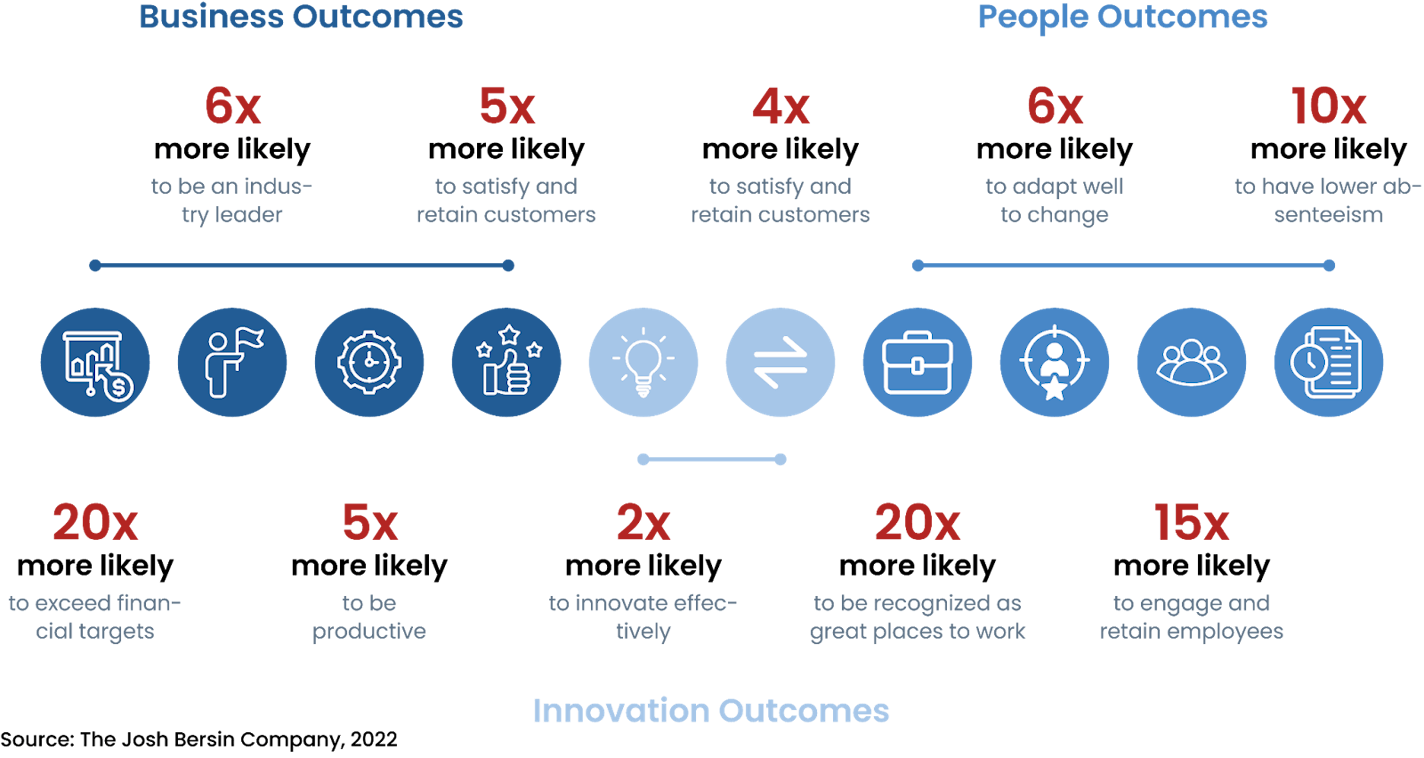
The three pillars of a high-performance culture
Culture is about people, and today we are in a people-first economy. Whether it’s because of COVID-19 or The Great Resignation or the rise of Gen Z can be debated. But it’s clear that the way we need to engage and motivate our employees has changed. As a result we need to rethink how we manage high-performing teams in an entirely different business context.
Leading organizations are redefining their human capital strategy around people-centric core principles to achieve a high-performance culture. What does that mean? It can be distilled down to three pillars, defined as follows:
Purpose
Caring about goals, alignment, motivation, engagement, your company values and culture.
Transparency
Providing compensation clarity, data clarity, pay equity, diversity, governance, risk, and compliance.
People first
Prioritizing the employee experience and journey, providing an employee-centric workplace and meaningful rewards.
Supporting these three pillars are compensation and performance management. The way we manage performance and reward our people is where the rubber meets the road. These key drivers play a big part in defining the corporate culture as experienced by employees, by demonstrating what the company truly values.
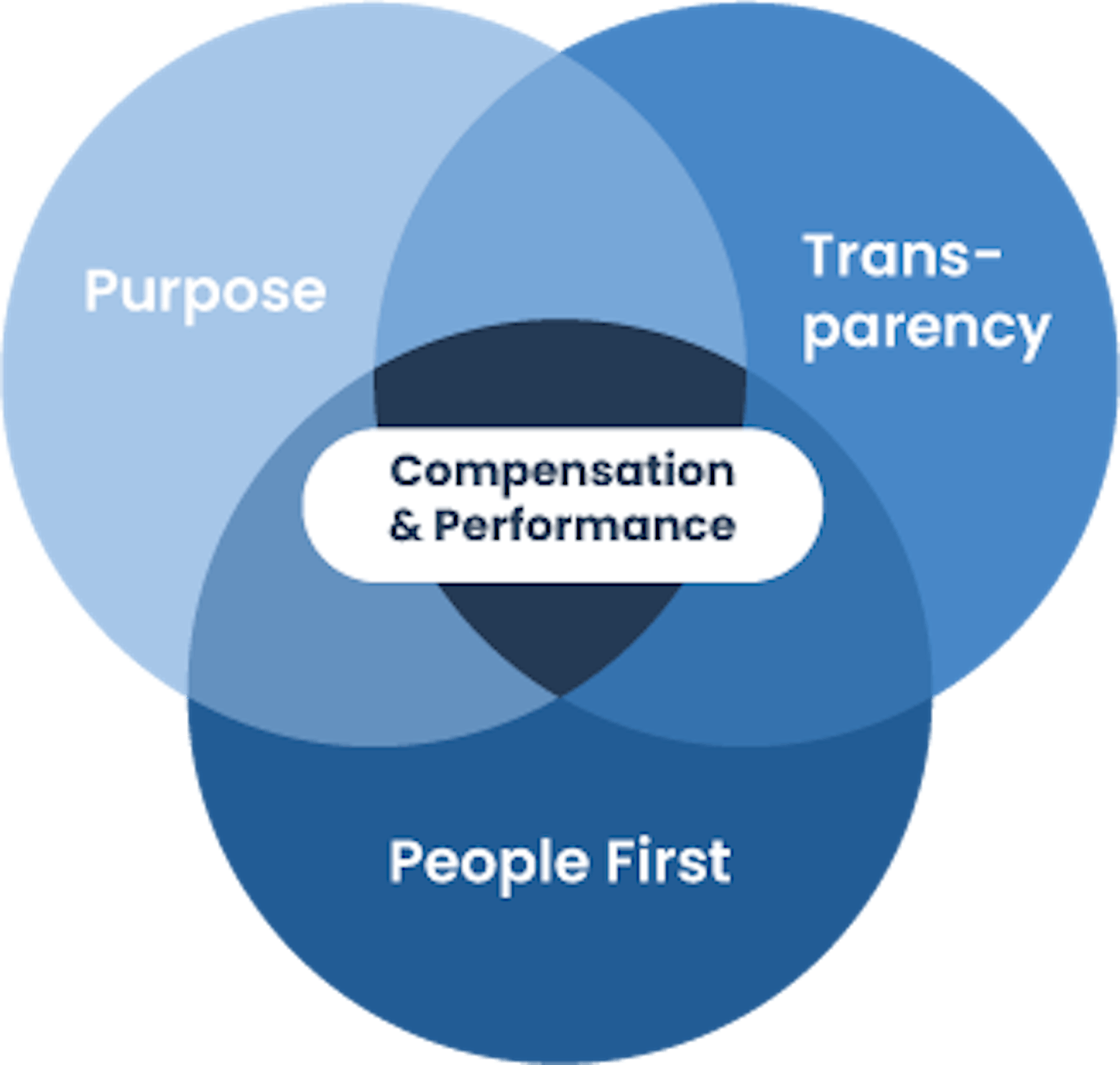
Pillar #1 – Purpose
“People don’t buy what you do, they buy why you do it,” says Simon Sinek. His “golden circle” places the “Why” at the center of what is important in a company, putting purpose, cause, and beliefs first, before the What or the How.
When employees understand the company’s purpose, it is easier for them to align and they are naturally more motivated. As Josh Bersin has reported, companies that have a sense of purpose embedded into their culture are six times more likely to have high engagement and retention.
To create a sense of purpose:
- Employees need to understand the “Why” of what they do
- Goals should:
- Be aligned with organization objectives
- Support employee development and skills
- Be agile, flexible, and adaptable
- Progress against goals, and effect on compensation, should be visible
- Company values should be part of an employee’s daily experience
When the above are in place, employees can feel that they are part of something bigger and understand how they are contributing to it.
Most companies do try to align rewards with measurable goals, but often the progress against goals and its effect on employee compensation is not visible, so the motivating value of the compensation is diminished. This also ties in with the pillar of transparency, which we will address further on.
The organization in turn can support the employee’s ability to contribute by supporting their development and skills. Some companies may even put a development plan in place for each employee.
If you want the company values to be reflected by your employees they need to be more than just a high-sounding statement on a poster or a website, they should be part of an employee’s daily experience. Those values should be built into the company, team, and individual goals, and employees should be recognized and rewarded for demonstrating those values.
Pillar #2 – Transparency
“Nothing alienates people more than getting a sense that their pay is unfair, behind, or unrepresentative of their achievement and contribution,” says Josh Bersin. “So, it’s critical to create a pay process that has clearly defined criteria, one that is transparent and easy to understand, and that managers are trained and supported in communicating it.”
A McKinsey study, The fairness factor in performance management, showed an extremely significant relationship between pay-for-performance, fairness, and differentiated compensation.
Transparency builds trust. Employees need to understand their total compensation and see how it was calculated, and know that it was fair. This is becoming an increasingly important focus for many companies as they seek to go beyond black-and-white offline reward statements and deploy engaging real-time total comp dashboards.
Transparency should enable employees, managers, and HR to:
- See how total comp was calculated
- Ensure pay equity, diversity & inclusion
- Support governance & compliance
- Reduce risk (attrition, reputation, legal)
- Get data clarity for performance and rewards
- Spot hidden trends and biases
Companies we talk to tell us their people have no transparency when it comes to their incentives, a situation they know needs to change. Often they have many complex bonus plans across different businesses, but no consistent way to show employees how their pay is determined or to provide a clear link between pay and performance. This runs the risk of alienating employees. Their business case for investing in a compensation system to improve transparency aims to increase engagement and employee performance, which will help to improve their company-wide results.
Pillar #3 – People first
An IBM thought leadership piece, Building a Human-Centered Organization, cites statistics showing that companies that adopt a human-centered approach to business see a 32% lift in revenue, deliver outcomes to their market 2x faster, and ultimately outperform the S&P by 211%.
IBM says a human-centered organization “focuses on creating better human experiences, builds resilience and de-risks innovation through continuous iteration and learning, cares as much about the experience of its diverse, empowered teams as it does about its customers, and intentionally, actively embeds these principles into the fabric of the organization.”
From a compensation and performance perspective, a people-first organization features:
- Employee-centric, tailored, meaningful rewards
- Pay that is fair and competitive
- Regular peer feedback to guide continuous self-improvement
- Focus on high adoption of performance processes
- Performance reviews that are useful to the employee, flexible, and timely
Let’s take a closer look at these.
Meaningful rewards
What rewards are “meaningful”? Typically the top two criteria for satisfaction with pay are that it is fair and competitive. Beyond that, it depends on the employee and their life circumstances and goals. Thus it can differ from employee to employee, and can also change over time. A Mercer study in 2022, Inside Employees Minds, asked employees what kept them up at night; “covering monthly expenses” went from 9th the year before COVID-19 to top priority afterwards. If your employees are worried about paying the bills, they won’t be performing well at work—and programs to improve purpose and transparency are not going to be effective.
Self-improvement
People first also includes helping employees perform, grow, and develop to reach their potential. That requires having enabling systems and processes in place to make it happen. It’s not simply a matter of learning new skills. There’s a lot of research that shows a strong correlation between a high-performing organization and continuous peer based feedback. A system to enable continuous peer feedback provides real-time guidance and helps employees to own their own self-improvement. Also important is to get regular coaching and check-ins with managers who are supported in being good coaches.
Adoption
If performance processes like goal-setting, feedback, coaching, and performance reviews are not people-first, they won’t be adopted. Many companies we talk to have major issues of low adoption or minimal adoption, where employees and managers do the bare minimum to complete performance management processes. So adoption is key—it’s the proverbial last mile. Think of all the money and time companies have invested in culture programs and performance systems, only for them to fail to be adopted by the workforce.
Performance reviews
Lastly, performance reviews have traditionally been seen as a necessary evil that makes everyone involved feel uncomfortable. They are in fact the perfect example of a process designed for HR and not structured to be people first. Many companies are looking to change their performance practices and in particular their performance reviews to be less about what HR needs, and more useful for the employee.
Houston, we have a problem
To implement the three pillars of high performance, it’s important that leadership has a clear-eyed view of the current realities in your organization. Here is where the problem often lies, preventing organizations from adopting and implementing the three pillars. In the performance arena there is often a perception gap, and in compensation there is generally a data gap. Both gaps prevent business leaders and HR from seeing the real picture and making the right decisions.
The performance reality gap
The performance reality gap is the difference between what executives believe is the reality in the organization vs. the employee perception.

From an executive perspective, the company values are crystal clear, well communicated and understood. Most likely, your CEO is living and breathing those values on a daily basis. Executives by default are high-performing individuals and they either expect everyone to naturally have that same kind of mindset or they expect line managers to be doing a great job of driving the culture.
To make matters worse, they get reassurance from the automated performance form, and they believe that employees are speaking regularly about performance with their supervisors.
But the perspective from employees is very different. Your employees are not necessarily living and breathing your company values. They might not even know what those are, and so they may not be engaging with the corporate purpose. Research shows that the vast majority of employees typically would like more dialog with their managers, even to the point of having it on a daily basis.
And as many of us know, for employees the performance review is a chore, and the typical performance management technology is hard to use and not engaging. Overall, employees are not engaging with the performance process because they’re not getting value from it.
The compensation data gap
Secondly, there’s a major problem with Compensation. In our discussions with companies, we hear constantly that what should be a simple goal—data clarity, or a single source of the truth—is actually the biggest pain point for HR leaders. Instead of data clarity they have:
- Limited data
- Missing data
- Outdated data/not real-time
- Misalignment between actions/behavior and rewards
Why? The most cited reason is the inflexible data model at the core of most HRIS systems, which usually does not or cannot hold all the required data or run the required calculations. For example, we often hear, “Our HRIS doesn’t do our bonuses,” or “Our HRIS can’t manage our LTI program.”
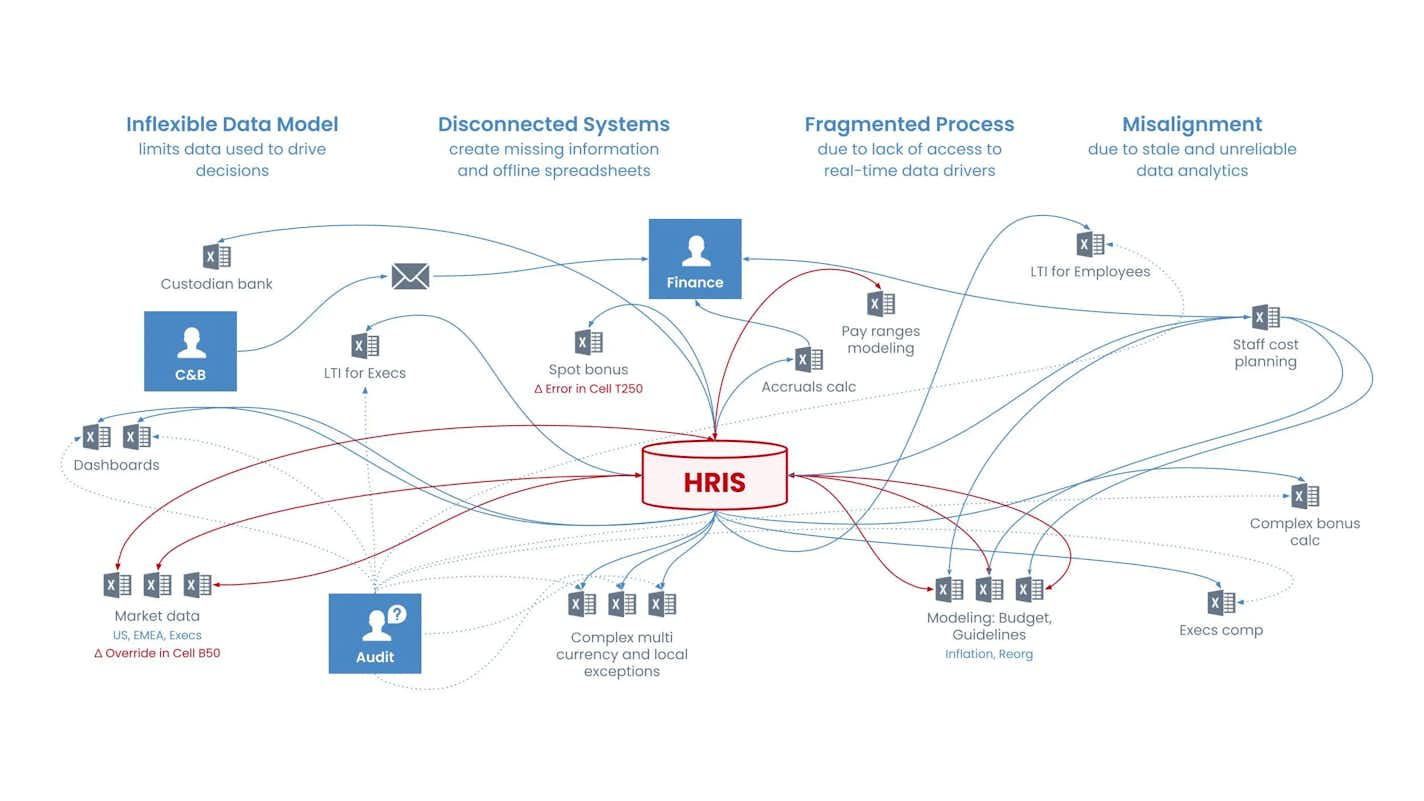
This results in multiple, disconnected systems that have grown around the evolving organization and are not easily or frequently talking to each other, resulting in:
- Missing information, or information stored in offline spreadsheets
- Fragmented processes, lack of integration and process automation
- Misalignment, due to stale and unreliable data analytics
- Little or no ability to make changes or adapt
The problem is all too clear and all too familiar. Without the full data story, you risk:
- Rewarding the wrong people for the wrong behaviors
- Not recognizing contributions to positive outcomes
- Decision bias and increasing pay gaps
- Non-compliant compensation practices
- Unreliable data for decision making
- Over/under paying
- System/process inefficiencies
Without data clarity, you cannot have transparency, you cannot have meaningful rewards that put people first, and you will not be able to align goals and actions with your purpose. No data clarity, no pillars of high performance.
The good news is, there is a new model for pay and performance that can eliminate both the performance reality gap and the compensation data gap.
A new model for pay and performance
Given the pillars of a high-performance organization and the roadblocks to implementing those pillars, a new model is needed that solves the fundamental data problem and enables a culture of purpose, transparency, and people first.
The new model represented by beqom is that of Unified Performance and Compensation. So, what does that actually mean?
Unified Performance and Compensation means having one platform that can hold and automate all the data you need for your compensation and performance programs. That is the foundation.
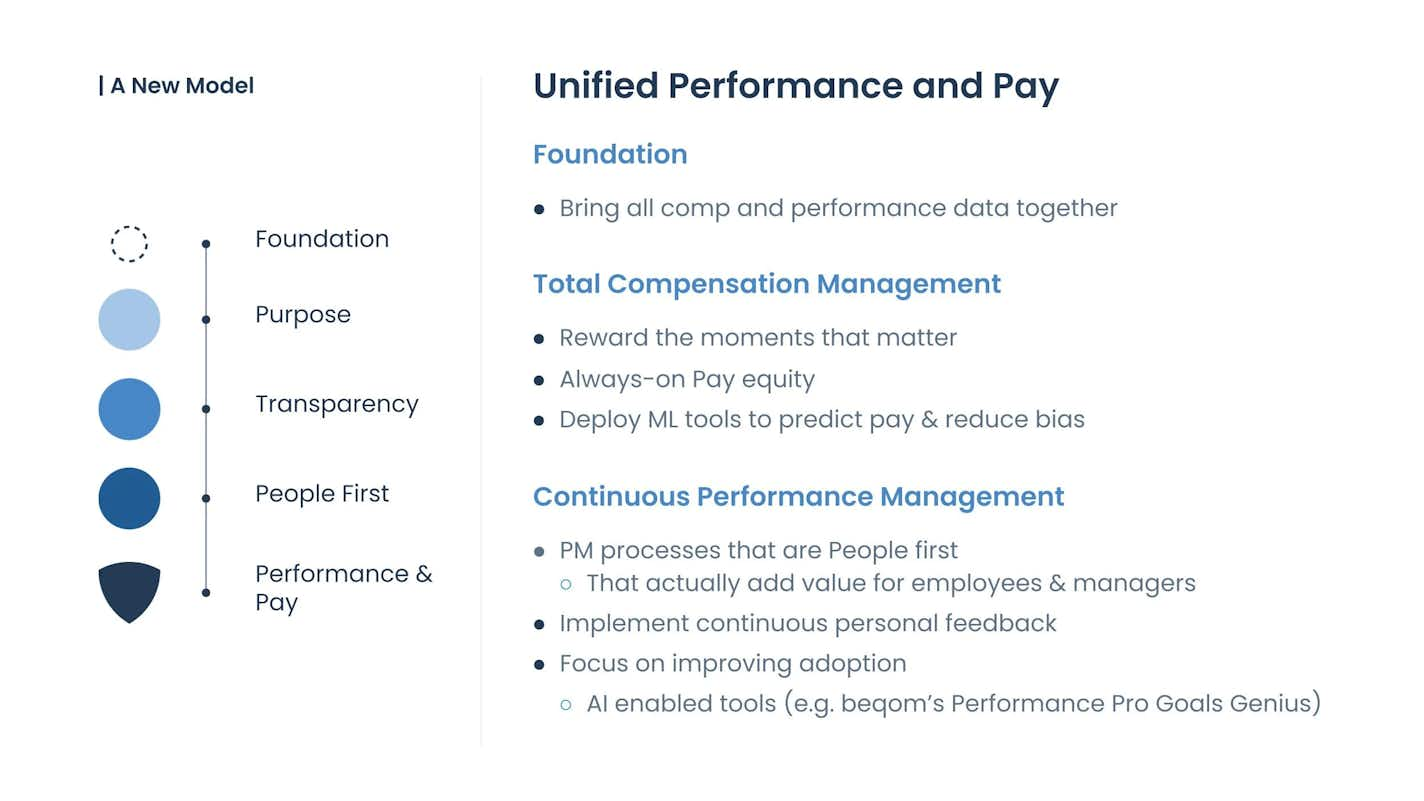
With that foundation in place, which includes the automation of many of the most time-consuming manual tasks around compensation and performance management, HR teams are freed up to focus on innovation and value-adds like:
Being more continuous. By that we mean being able to deliver continuous performance management and even continuous compensation, what we call “rewarding the moments that matter.” Employees work every day, but their bonus is paid once a year or every six months and becomes disconnected from the work. By providing compensation or recognition on a more regular basis, you can put employees first by delivering their rewards in real-time.
Always on pay equity. Organizations are moving beyond an annual pay equity audit. In the old model, you extract your data and produce your pay equity reports—one and done. The new model means deploying tools that address pay equity throughout the year. For example, one company is using a pay equity tool for managing new hires and promotions, empowering team leaders to make better, data-driven decisions, with improved pay guidelines based on compensation modeling that highlights the pay equity implications.
Implementing ML and prediction tools. Now that we have machine learning (ML) tools that can help to automate pay recommendations, it becomes easier to achieve pay equity and transparency, and to generate intelligent pay ranges. Compensation modeling tools can guide managers during annual cycles to make data-driven decisions and avoid bias.
Continuous performance management (CPM). CPM enables performance processes that are integrated into the daily workflow and are people-first: owned by employees and managers, not imposed by HR. As such they actually add value for employees by helping them with their own development, and help managers with coaching their employees. This includes features such as agile goal-setting, continuous peer feedback, guided manager check-ins, and flexible performance reviews, all aligned with company objectives and values.
Achieving performance success
The three pillars of a high-performing culture are Purpose, Transparency, and People-first. But achieving those can be a big challenge. Success will be defined not only by attracting new talent; it will be determined by inspiring and rewarding new levels of engagement and motivation in the existing team, while bringing new efficiencies and top results to the organization.
The solutions exist to transform compensation and performance processes to deliver on the promise of the three pillars. For more information or a demo, contact the compensation and performance experts at beqom.





